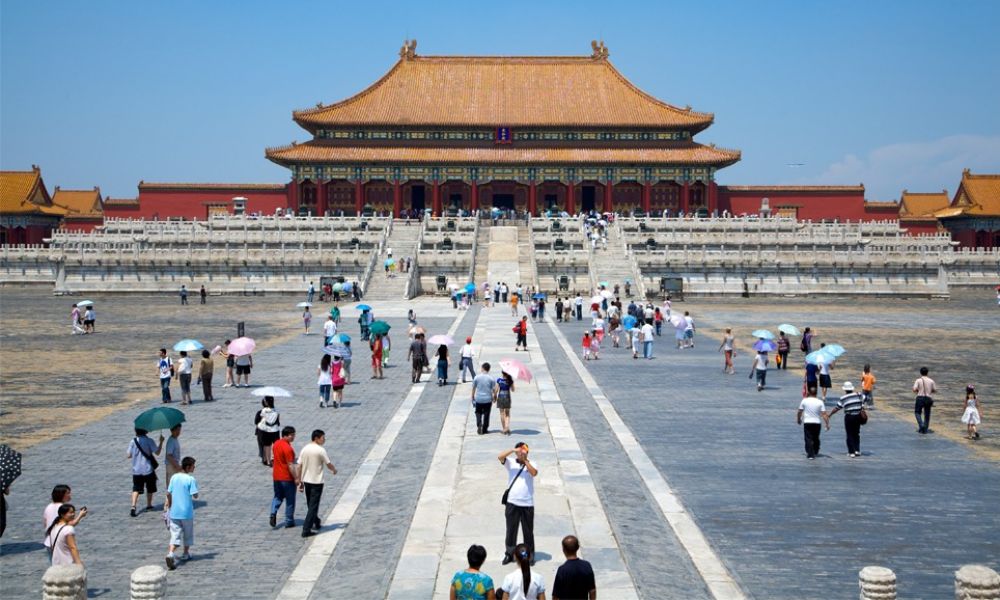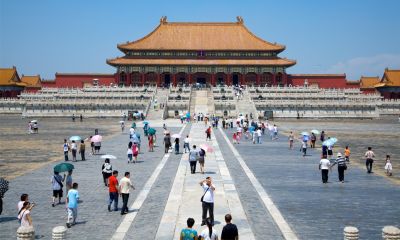

The flag-raising ceremony at Tiananmen Square is a symbolic and patriotic event that takes place every day at sunrise. This time-honored tradition involves a highly disciplined unit of the People's Liberation Army marching out from the Forbidden City towards the flagpole in perfect synchronization. Tourists and locals alike gather in large numbers to witness the meticulous precision of the soldiers as they hoist the Chinese flag. The ceremony is free to watch and offers insight into the country's military customs and national pride. Attendees usually arrive early to secure a good viewing spot and experience the awakening of the capital city amidst the backdrop of one of the world's largest public squares.
Located in the center of Tiananmen Square, the Monument to the People's Heroes is an imposing structure dedicated to the martyrs of revolutionary battles throughout China's modern history. Standing at over 37 meters tall, this granite monument is adorned with reliefs depicting pivotal moments and figures in China’s fight for freedom and progress. Visitors can walk around the monument to view the intricate sculptures and engravings that tell the story of sacrifice and patriotism. A visit to this historical landmark lends a deeper understanding of China's past struggles and is a poignant reminder of the human cost of its achievements. Take a moment here to reflect and honor those who have paved the way for the nation's future.
Exploring Tiananmen Square on foot is a must-do activity when visiting Beijing. As one of the largest city squares in the world, this vast expanse is steeped in history and significance. A walking tour can include visits to key landmarks such as the Tiananmen Tower, the Great Hall of the People, and the National Museum of China. Knowledgeable guides will recount stories and facts about the infamous 1989 protests, as well as the square's role in major events throughout China's history. Most walking tours last about 1 to 2 hours, allowing ample time to absorb the atmosphere of this iconic location and to snap memorable photographs against the backdrop of historical and cultural monuments.
Adjacent to Tiananmen Square, the National Museum of China invites visitors to traverse the vast expanses of Chinese history and art. Boasting an impressive collection that spans from ancient times to the modern era, the museum showcases artifacts, jade pieces, ceramics, and calligraphy, along with revolutionary history and contemporary works. One can easily spend several hours exploring the numerous exhibitions that illustrate China's cultural evolution and artistic achievements. The museum is also an architectural marvel, with grand halls and elegant spaces that create a fitting backdrop for the treasures within. Due to the sheer scale of its collections, visitors might consider focusing on specific galleries or exhibitions that interest them the most to make the most of their time in the museum.
Chairman Mao Memorial Hall, also known as the Mausoleum of Mao Zedong, is a site of deep cultural and historical significance situated in Tiananmen Square. This somber and respectful attraction houses the embalmed body of Mao Zedong, the founding father of the People's Republic of China. Visitors queue up to enter the hall, where they can pay their respects to Chairman Mao's remains, which are displayed in a crystal coffin. Since its opening in 1977, the site has drawn millions of visitors from across China and around the world. Photography is not allowed inside, and visitors are expected to maintain a solemn and respectful demeanor. The duration of the visit is relatively short, as the viewing is quick due to the steady flow of the crowd, but the wait time can vary depending on the number of visitors.
The Great Hall of the People is an imposing state building located along the western edge of Tiananmen Square. Serving as the meeting place of the National People's Congress, China's legislative body, the Great Hall is also used for other political and ceremonial activities. Visitors have the opportunity to tour some of its open areas when the congress is not in session, including several halls used for diplomatic meetings and banquets. The grandeur of the Great Hall is apparent in its massive auditorium, which can seat thousands of people, and the opulent Banquet Hall, used for state dinners. Tours offer a glimpse into the grandiose nature of Chinese state affairs, as well as the architectural prowess evident in the hall's design and construction. This is a unique chance to see the inner workings of China's government.
The Tiananmen Tower, also known as the Gate of Heavenly Peace, is the iconic symbol of Beijing and the People’s Republic of China. Standing at the northern end of the square, this historic landmark once served as the entrance to the Imperial City, and its image is emblazoned on national emblems. Visitors can climb the tower to gain a panoramic view of the sprawling Tiananmen Square, which is especially impressive on clear days. The climb also offers a unique perspective of the bustling crowds below and the surrounding monuments. While exploring Tiananmen Tower, one can delve into its historical significance, as the site where Chairman Mao announced the establishment of the People's Republic of China in 1949, and learn about its architectural features that have stood for centuries.
Kite flying is a traditional Chinese pastime that has been enjoyed for generations, and Tiananmen Square provides an ideal location for this leisurely activity. With its vast open space and typically breezy conditions, the square is a popular spot for locals and tourists to fly kites. Visitors can bring their own kite or purchase one from nearby vendors, who offer a variety of colorful and intricate designs, from simple diamond-shaped kites to elaborate dragons and birds. Engaging in this activity not only allows for relaxation and fun but also provides a chance to interact with local families and immerse yourself in a cultural tradition. It's an excellent way to spend a sunny afternoon in the heart of Beijing, enjoying the outdoors and the festive atmosphere created by the myriad of kites dotting the sky.
Just a short walk from Tiananmen Square, the Beijing Urban Planning Exhibition Hall is a fascinating site for those interested in the development and future of China's capital city. This lesser-known museum showcases the evolution of Beijing's urban landscape through detailed models, interactive displays, and historical photographs. One of the hall's highlights is a massive scale model of the entire city, offering an aerial perspective on Beijing's layout, landmarks, and sprawling development. Visitors can learn about urban planning strategies, historical preservation efforts, and envisioned projects that aim to shape the future of Beijing. Exploring this exhibition hall is an eye-opening experience that provides a different vantage point on the city beyond the traditional historical and cultural sites.
While not an activity confined to Tiananmen Square itself, sampling Beijing's local cuisine is an essential part of visiting the area. The streets and alleys surrounding the square are replete with food stalls, traditional eateries, and teahouses offering an array of Chinese delicacies. From savory Peking duck to sweet-and-sticky candied hawthorns on a stick, the options are diverse and tantalizing. Numerous restaurants in the vicinity offer menus that feature both familiar dishes and regional specialties, making it an excellent opportunity to indulge in China's rich culinary heritage. Food lovers can take a guided food tour to learn about the ingredients, history, and cultural significance of each dish they try. Exploring the local flavors adds a delicious dimension to the Tiananmen Square experience and is an activity that engages all the senses.
